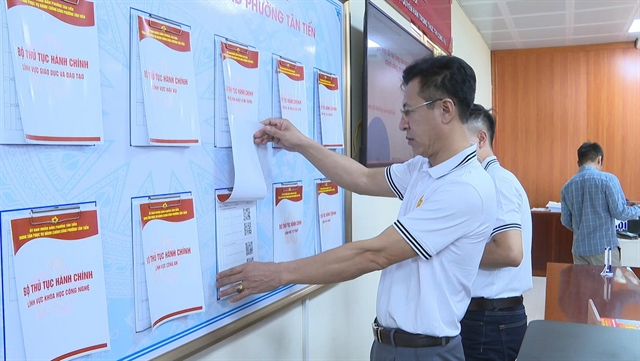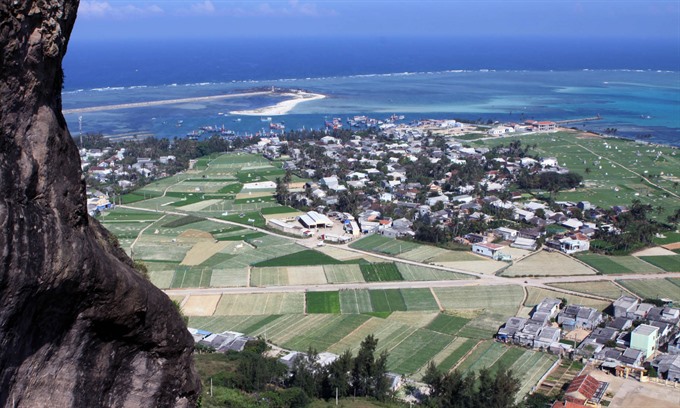 Society
Society

Pollution, fishing by electric shock tools and explosive, rapid infrastructure for tourism service as well as poor co-ordination mechanism among state agencies and local administrations have seen as major challenges for protection and management at Marine-protected areas (MPAs).
 |
| Lý Sơn Island, consisting of three communes – An Vĩnh, An Hải and An Bình seen from Thới Lới Mountain. An Bình Islet on Lý Sơn Island, off the coast of Quảng Ngãi Province is a newly established Marine Protected Area. — VNA/VNS Photo Thanh Long |
ĐÀ NẴNG — Protected marine areas (MPAs) in the country face the serious threats of pollution, dynamite and electric shock fishing and haphazard infrastructure construction for tourism.
These threats are exacerbated by poor co-cordination between State agencies and local administrations.
This critical situation was highlighted at the National Seminar on Management Effectiveness Evaluation held in the central city of Đà Nẵng yesterday .
Representatives from 16 MPAs and several NGOs attended the seminar.
“Only 0.17 per cent of total sea area (1 million square kilometres) has been targeted for strict conservation, and we target increasing this to 0.24 per cent in the coming years,” said Nguyễn Thanh Bình, deputy head of Department of Conservation and Aquatic Resources Development.
There is almost no area in MPAs that have been declared off limits to fishing, he said.
Bình said slow planning and a weak legal framework have been identified as hurdles to strengthening enforcement at MPAs.
He said more effective measures have been planned for the 2016-2020 period, including expanding the MPAs, biodiversity supervision and community management.
Deputy head of Directorate of Fisheries, Lê Trần Nguyên Hùng, said a policy was needed to communities shifting to other vocations to ease pressure on MPAs, given that most people living in their vicinity were poor.
“Many local administrations people have focused exclusively on tourism development in the MPAs, and some of them have even reserved core zones for this purpose,” Hùng said.
He said the problems of inadequate funding, redundant legal documents as well as poor co-operation between central agencies and local administrations have to be dealt with in a clear and transparent manner.
According to Directorate of Fisheries under the Ministry of Agriculture and Rural development, Hòn Mê Island, Nam Yết, Phú Quý and Hải Vân-Sơn Trà are set to become MPAs in the future.
Bùi Thị Thu Hiền, Marine & Coastal Programme Co-ordinator for the International Union for the Conservation of Nature and Natural Resources (IUCN), said MPAs in Việt Nam should strongly punish violations of the environment.
“Fishing with electric shock and over-fishing are still happening in MPAs nationwide, while construction of infrastructure for tourism services have been stepped up by local administrations,” Hiền said, adding that there was still a misunderstanding that MPAs have only been established for the purpose of serving tourism.
“Coral reefs and seaweed beds have been degraded, thus fish and marine species living in coral reefs have reduced. Meanwhile, poor quality of sea water and heavy pollution from coastal lines have worsened the situation,” she said.
Hiền said not much research is being done on biodiversity and coral reefs development in MPAs.
She suggested that MPAs reserve part of their tourism service proceeds to enhance management and protection of the nation’s marine environment.
According to latest reports, the Hạ Long Bay Heritage Management board earned VNĐ783 billion (US$35 million) from tourism service last year and 18 per cent of this revenue was returned to MPAs for conservation activities.
Chàm Islands-Hội An – a world biosphere reserve recognised by UNESCO in 2009 – has been seen as good example in management and conservation.
The Chàm Island MPA management board has successfully carried out ‘No Plastic Bag’ and ‘No Fishing’ campaigns.
The Chàm Island has banned fishing on 0.5 per cent of the total 6,716ha sea area, and will increase this to 10 per cent in coming years.
It has reserved 50 per cent of the total $650,000 in revenues for conservation and protection of the MPA. — VNS




